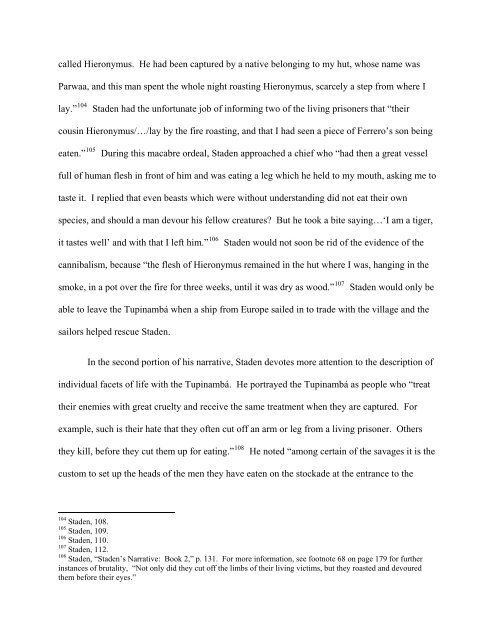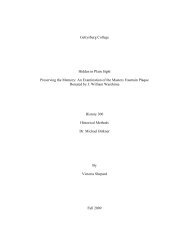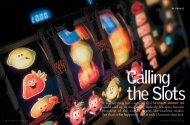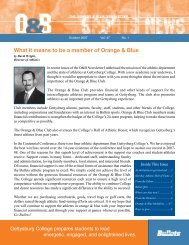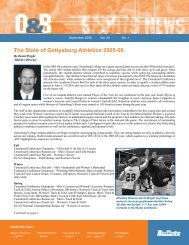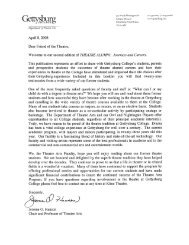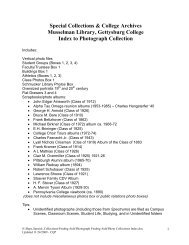Sweet Tooth for Empire: Sugar and the British Atlantic World
Sweet Tooth for Empire: Sugar and the British Atlantic World
Sweet Tooth for Empire: Sugar and the British Atlantic World
Create successful ePaper yourself
Turn your PDF publications into a flip-book with our unique Google optimized e-Paper software.
called Hieronymus. He had been captured by a native belonging to my hut, whose name was<br />
Parwaa, <strong>and</strong> this man spent <strong>the</strong> whole night roasting Hieronymus, scarcely a step from where I<br />
lay.” 104 Staden had <strong>the</strong> un<strong>for</strong>tunate job of in<strong>for</strong>ming two of <strong>the</strong> living prisoners that “<strong>the</strong>ir<br />
cousin Hieronymus/…/lay by <strong>the</strong> fire roasting, <strong>and</strong> that I had seen a piece of Ferrero’s son being<br />
105<br />
eaten.” During this macabre ordeal, Staden approached a chief who “had <strong>the</strong>n a great vessel<br />
full of human flesh in front of him <strong>and</strong> was eating a leg which he held to my mouth, asking me to<br />
taste it. I replied that even beasts which were without underst<strong>and</strong>ing did not eat <strong>the</strong>ir own<br />
species, <strong>and</strong> should a man devour his fellow creatures? But he took a bite saying…‘I am a tiger,<br />
it tastes well’ <strong>and</strong> with that I left him.” 106 Staden would not soon be rid of <strong>the</strong> evidence of <strong>the</strong><br />
cannibalism, because “<strong>the</strong> flesh of Hieronymus remained in <strong>the</strong> hut where I was, hanging in <strong>the</strong><br />
smoke, in a pot over <strong>the</strong> fire <strong>for</strong> three weeks, until it was dry as wood.” 107 Staden would only be<br />
able to leave <strong>the</strong> Tupinambá when a ship from Europe sailed in to trade with <strong>the</strong> village <strong>and</strong> <strong>the</strong><br />
sailors helped rescue Staden.<br />
In <strong>the</strong> second portion of his narrative, Staden devotes more attention to <strong>the</strong> description of<br />
individual facets of life with <strong>the</strong> Tupinambá. He portrayed <strong>the</strong> Tupinambá as people who “treat<br />
<strong>the</strong>ir enemies with great cruelty <strong>and</strong> receive <strong>the</strong> same treatment when <strong>the</strong>y are captured. For<br />
example, such is <strong>the</strong>ir hate that <strong>the</strong>y often cut off an arm or leg from a living prisoner. O<strong>the</strong>rs<br />
<strong>the</strong>y kill, be<strong>for</strong>e <strong>the</strong>y cut <strong>the</strong>m up <strong>for</strong> eating.” 108 He noted “among certain of <strong>the</strong> savages it is <strong>the</strong><br />
custom to set up <strong>the</strong> heads of <strong>the</strong> men <strong>the</strong>y have eaten on <strong>the</strong> stockade at <strong>the</strong> entrance to <strong>the</strong><br />
104 Staden, 108.<br />
105 Staden, 109.<br />
106 Staden, 110.<br />
107 Staden, 112.<br />
108 Staden, “Staden’s Narrative: Book 2,” p. 131. For more in<strong>for</strong>mation, see footnote 68 on page 179 <strong>for</strong> fur<strong>the</strong>r<br />
instances of brutality, “Not only did <strong>the</strong>y cut off <strong>the</strong> limbs of <strong>the</strong>ir living victims, but <strong>the</strong>y roasted <strong>and</strong> devoured<br />
<strong>the</strong>m be<strong>for</strong>e <strong>the</strong>ir eyes.”


